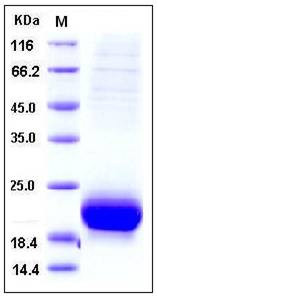Human VEGF-D / VEGFD / FIGF Protein (His Tag)
VEGF-D,VEGFD
- 100ug (NPP1286) Please inquiry
| Catalog Number | P10557-H08H |
|---|---|
| Organism Species | Human |
| Host | Human Cells |
| Synonyms | VEGF-D,VEGFD |
| Molecular Weight | The recombinant mature form of human VEGFD consists of 120 amino acids and has a predicted molecular mass of 13.6 kDa. In SDS-PAGE under reducing conditions, it migrates with an apparent molecular mass of 20-22 kDa due to glycosylation. |
| predicted N | Phe 93 |
| SDS-PAGE |  |
| Purity | > 95 % as determined by SDS-PAGE and SEC-HPLC Analysis. |
| Protein Construction | A DNA sequence encoding the mature form of human VEGFD (NP_004460.1) corresponding to amino acid (Phe 93-Ser 201) was expressed with a C-terminal polyhistidine tag. |
| Bio-activity | Measured in a cell proliferation assay using human umbilical vein endothelial cells (HUVEC). The ED50 for this effect is 0.3‑1.6 μg/mL. |
| Research Area | Cardiovascular |Angiogenesis |Growth Factor & Receptor |Vascular Endothelial Growth Factor (VEGF) & Receptor |Vascular Endothelial Growth Factor (VEGF) |
| Formulation | Lyophilized from sterile PBS, pH 7.4 1. Normally 5 % - 8 % trehalose and mannitol are added as protectants before lyophilization. Specific concentrations are included in the hardcopy of COA. |
| Background | Vascular endothelial growth factor D (VEGF-D), also known as C-fos induced growth factor (FIGF), belongs to the platelet-derived growth factor/vascular endothelial growth factor (PDGF/VEGF) family. FIGF protein is active in angiogenesis, lymphangiogenesis, and endothelial cell growth. FIGF protein is secreted as a non-covelent homodimer in an antiparallel fashion. Human FIGF protein is expressed in adult lung, heart, muscle, and small intestine, and is most abundantly expressed in fetal lungs and skin. FIGF protein is structurally and functionally similar to VEGF-C. Therefore, FIGF protein binds and activates VEGFR-2 (Flk1) and VEGFR-3 (Flt4) receptors, and may particularly be involved in cancers, such as breast cancer, epithelial ovarian carcinoma and so on. |
| Reference |
